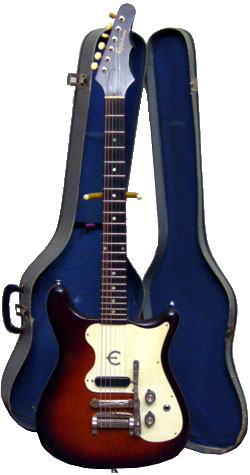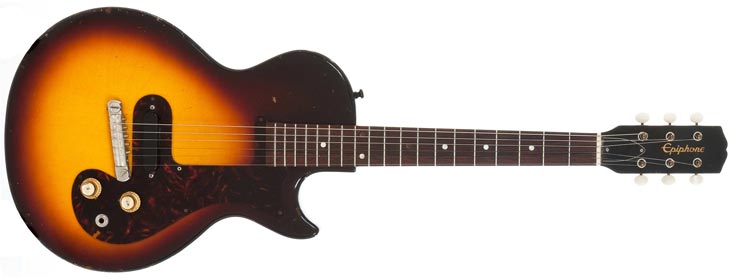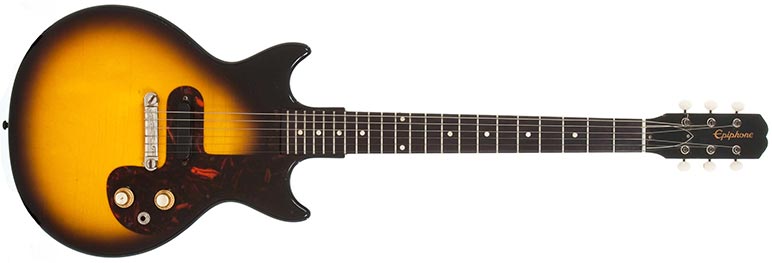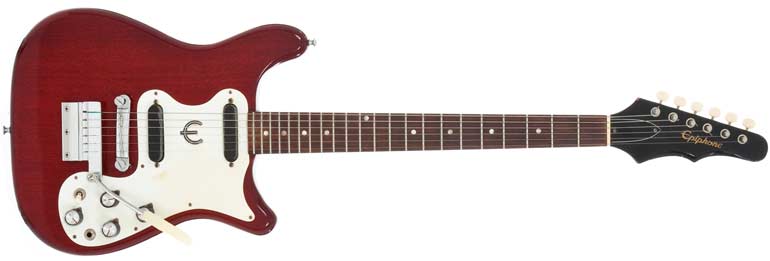

The Epiphone Olympic was the entry level CMI/Gibson-made Epiphone solid body - also the best selling of all 1960s Epiphone solids. In fact the Olympic, and the very similar Olympic Special don't represent just one guitar - the design changed (somewhat confusingly) several times over the nine years of production, though the basic specifications did not. Vintage Epiphone Olympic guitars are just as collectable (though not as highly priced) as other USA-built Epiphone models, especially instruments with the earlier body styles.
The Epiphone solid-body range could be directly correlated to the Gibson solid-body range sharing many features: hardware, pickup configurations, body and neck woods, construction and controls. They were all made at Gibson's Kalamazoo factory, so this is not surprising. The Olympic corresponds to the Gibson Melody Maker, both fitted with identical hardware, built with the same construction, the same design (until 1963) and having the same price tag. Both single-pickup instruments cost $149.50 in 1/10/66, double pickup models cost $179.50. The only real way to tell these guitars apart was the headstock shape and branding.
Like the Melody Maker, the Olympic started out with a Les Paul style single cutaway body (see the 1961 Epiphone Catalogue), both models changing to the same double-cutaway design, most-likely in late 1961 (see the 1962 Epiphone Catalogue). The two superb examples shown below come from 1961 and 1963 respectively, before changing again in late 1963.
 Image Heritage auctions
Image Heritage auctions
 Image Heritage auctions
Image Heritage auctions
Prior to mid/late 1963, all other Epiphone solid body guitars and basses had the same almost-symmetrical body style. The Olympic was very much the exception. Then in 1963, the (now) better-known non-symmetrical body style (with 'batwing' headstock) was introduced to all models, including the Olympic. But the 'old' (double cutaway) Olympic continued, as a single pickup guitar only, with the name Olympic Special. The only difference between a 1962 single pickup Olympic and a 1963 Olympic special was the date it was built! The Melody Maker ultimately changed body style too, (though not until 1966) when it became another guitar in the SG line.
For the rest of the decade, the Olympic kept the same familiar 'Epiphone' body style of the rest of the solid body series, though the Olympic special did change cutaway shape everso subtley.
 Image Heritage auctions
Image Heritage auctions
Of course, the changes in body style made for a very different looking instrument, but more importantly, a very different playing instrument. The first, single cutaway had quite limited neck access and only 19 frets. The neck joined the body at the 12th fret, making access to the highest notes quite tricky. The second double cutaway version had a 22 fret neck, joining the body at the 16th fret. Note how much further forward on the body the bridge is in this second version. It is overall a longer guitar. Finally, the last style has a neck/body join at the 21st fret, giving by far the best access to the top end of the fretboard. With the extra headstock length, this version had, by far, the longest total length.
The Epiphone Olympic was Epiphone's best selling (Kalamazoo-built) guitar, shipping almost 10,000 instruments between 1960 and 1969. Of course there were several variants in specification, with single (SB722) and dual (SB722D) pickups, with and without a vibrola, and (between 1960 and 1963) 3/4 scale (SB722 3/4) student models, just like the Gibson Melody Makers - though the Gibson student model remained in production right through the decade. For a break-down of the production stats, and comparison, see the Epiphone Olympic shipping totals and Gibson Melody Maker shipping totals.
The specifications for the different models are summarised in the table below.
| Model | Olympic SB722 | Olympic Double SB722D | Olympic SB722 3/4 |
| Available | 1960-1969 | 1960-1969 | 1960-1963 |
| Pickups | One Melody Maker style PU380 single coil pickup | Two Melody Maker style PU380 single coil pickups | One Melody Maker style PU380 single coil pickup |
| Scale | 24 3/4" | 24 3/4" | 22 3/4" |
| Body | Solid mahogany. 1960-1961 Les Paul style single cutaway: 12 3/4" wide, 17 1/4" long, 1 3/8" thick 1961-1963 Les Paul style double cutaway: 12 3/4" wide, 17 1/4" long, 1 3/8" thick 1963-1969 Wilshire / Crestwood style double cutaway: 12 3/4" wide, 15 5/8" long, 1 3/8" thick | ||
| Neck | One-piece mahogany, rosewood fingerboard with dot inlays. No binding. Early models had a double sided headstock, changing around late 1963 to the Epiphone batwing one-sided headstock | ||
| Frets | 19 (1960-61) 22 (1962-69) | 19 (1960-61) 22 (1962-69) | 19 |
| Hardware | 1 volume and 1 tone controls. Metal offset bridge with optional vibrola tailpiece. Plastic enclosed strip tuners. | 2 volume and 2 tone controls. Metal offset bridge with optional vibrola tailpiece. Plastic enclosed strip tuners. | 1 volume and 1 tone controls. Plastic enclosed strip tuners. |
| Finishes | Cherry, Sunburst and custom colours: Sunset Yellow, California Coral, Pacific Blue | ||
$2000
$2500
$1499
$2695
$2795
$3195
$1450
€1850
€1333
£1698
£1179
€1295
€1350
£1500